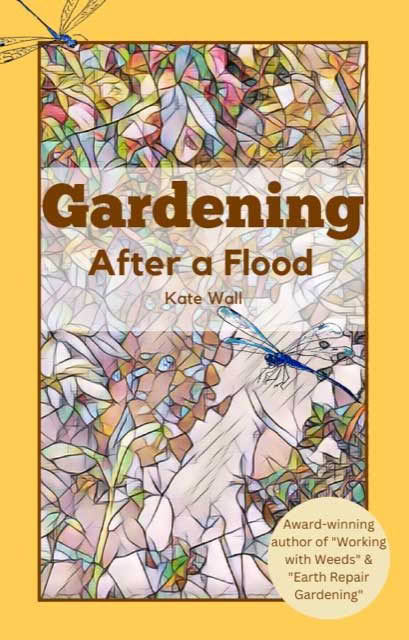Gardening after a flood: Kate Wall shares how to restore your soil and save stressed trees
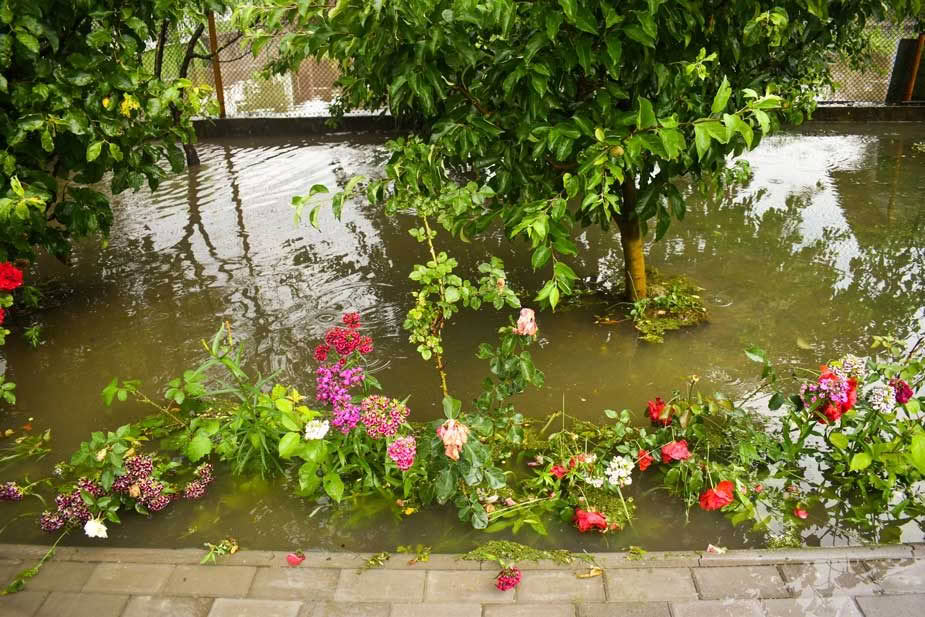
Kate Wall knows a lot about flooding. The gardener and author lives in Yeronga, a suburb on the Brisbane River in Queensland that is highly flood prone. In the major floods of 2011 her local community was devastated by flood waters and she found herself with little work. She kept herself busy helping gardeners restore their land. She shares the lessons she learnt restoring more than 150 gardens in Brisbane in this special extract from her book Gardening After a Flood.
Restoring your garden after flooding
The obvious signs of flood-damaged gardens are dead plants and layers of mud. What is less obvious is the damage flooding does to the soil. This soil damage can cause plants (especially trees) to die slowly many months after the flood, it can cause new plants to fail, and can create awful soil which is just too hard to garden in. There are steps we can take to make a huge difference in reducing the long-term damage caused by flooding to our garden and our soil.
The purpose of the book Gardening After a Flood is to guide you through what can be done to minimise harm in the short term and to reverse the damage in the long term. A few simple tasks done sooner rather than later will make a huge difference to the amount of effort required to restore your garden. If you cannot get to your garden for some time following the flood, all is not lost. The advice here will still help you recreate good soil and a garden you can enjoy. Restoring the garden is usually something you can do yourself, without needing qualified help or payouts from insurance. In a time when everything feels overwhelming, it can be very empowering to have something that you can take control of. A garden with fresh green growth is always a thing of beauty and hope. When your world has turned to mud, don’t underestimate the power of positivity that comes with a little bit of revival in the garden. For gardeners who are trying to recover their garden after flooding, I salute you.
The sooner the better
The sooner you get into the garden, the more you will save in terms of plants. But during this difficult time the garden is about more than just saving plants, it’s about saving your mental health. While you are in limbo and waiting for the chance to work on your home, make the effort to get into the garden. Rarely is the garden covered by insurance, therefore it is much less dependent on a successful claim. Clean up the garden rather than look at mud every day. You need to see hope and a return to life. This is not hard to make happen. Plants can start to shoot green again fairly quickly with the right help. You may not have access to a team of volunteer helpers and may find yourself alone and trying to recover. This is tough, really tough, but you can do it. Having a safe place to live is, of course, more important than having a garden. This is not about prioritising the garden over the home. It’s not one or the other. It’s about doing a little bit early to make sure it all works for you when you do have time for it. Flooding does cause significant soil damage. The severe compaction of the soil makes gardening again later very difficult. My experience of waiting six months after a flood to be able to get to some gardens meant that the soil by then was so hard that it was almost impossible to dig. Sometimes you just don’t have a choice about when you can get to the garden. Follow the advice here when you can, and you will still make a huge difference.
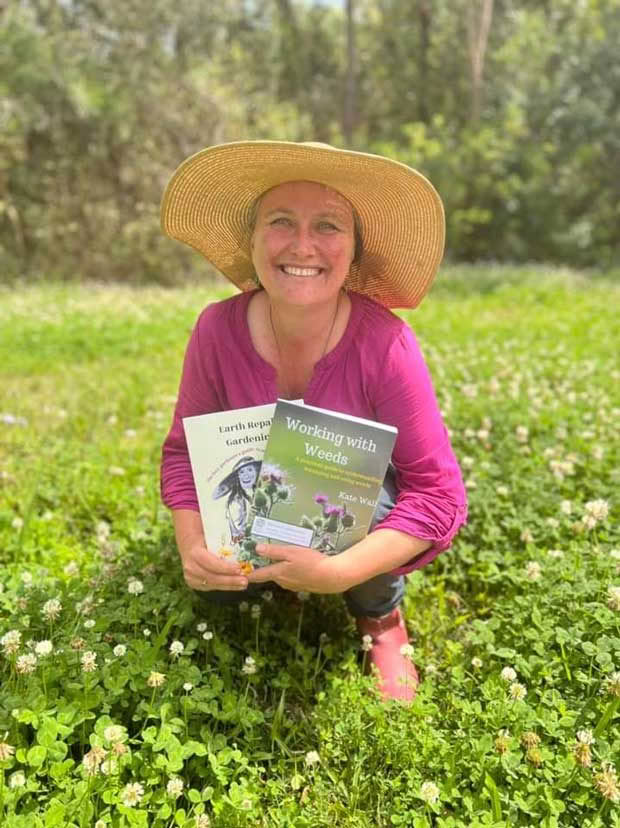
Gardener and author Kate Wall.
The garden clean up
Water blast the garden
During the clean-up phase you probably have volunteers in your home with a pressure washer/ water blaster. Once the house has been hosed out, ask them if they can spare an extra hour to keep going in the garden. Get as much mud off the plants as you can. I know it sounds extreme to pressure wash/ water blast plants, but it is very much needed at this point. Plants cannot photosynthesise when their leaves are covered in mud. The mud stops light reaching the leaves and clogs the tiny openings which allow gas exchange, a critical part of photosynthesis. Even the lawn should be pressure hosed to get as much mud off as possible. If you have been able to do this, and nothing else, you will save so much of your garden. When plants can breathe again, they can get back to the business of growing. Cleaning up any debris in the garden can wait until you are ready to tackle it. Once you have done an initial mud removal, go and rest. While the ground is waterlogged, any trampling over it to try and get things done will only add to the compaction. With the possible exception of animal carcasses, everything else can wait for things to start drying out a little.
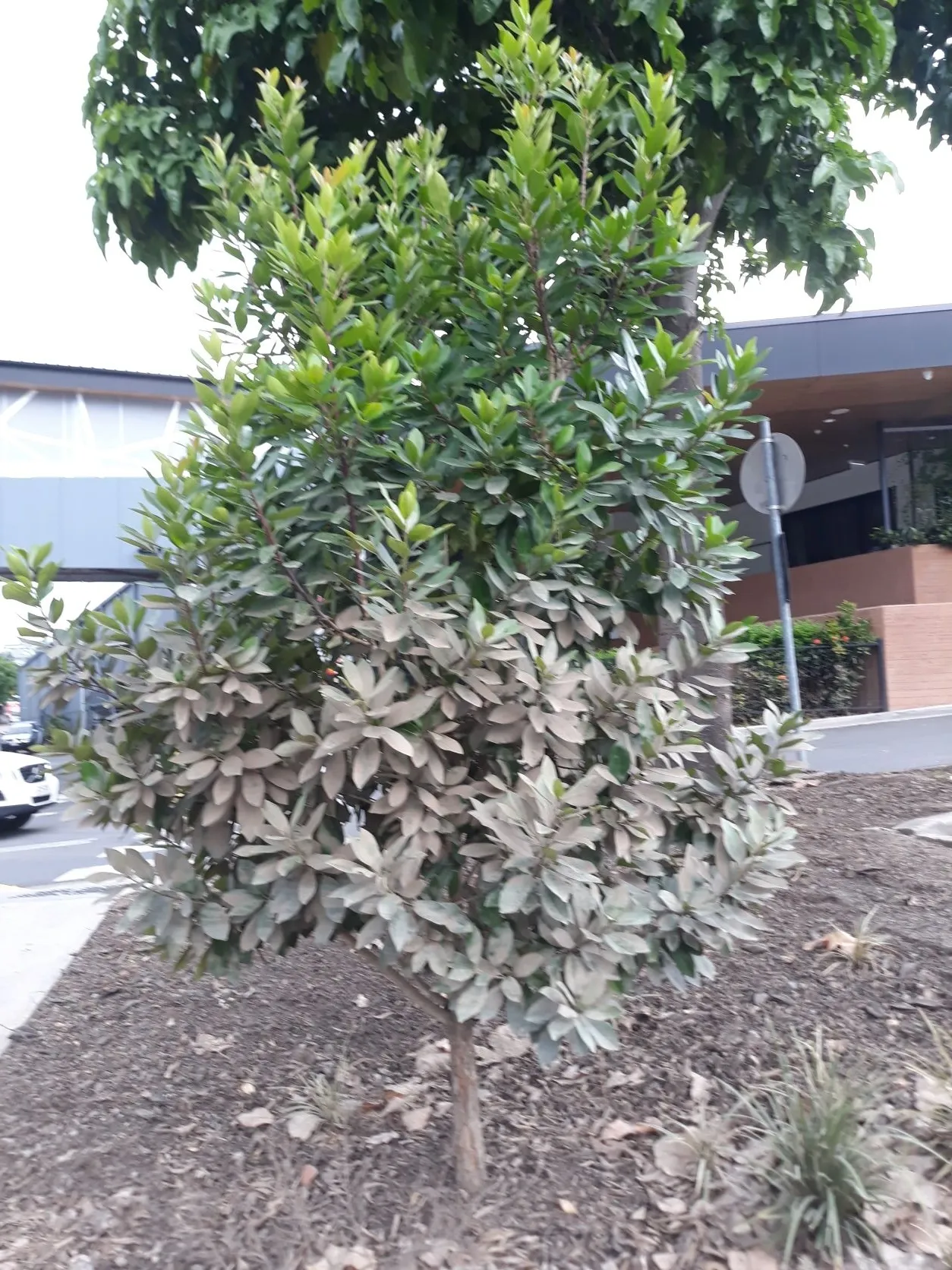
Trees covered in flood silt will not be able to photosynthesize. Photo Kate Wall.
Cleaning up debris
The debris can wait until you are ready. Of course, the sooner you can get to it, the sooner you get to stop looking at the mess. When you venture into the garden, be aware that all sorts of things may have washed through, so be sensible. Closed in shoes, long pants and long sleeves are preferable. And make sure your tetanus shots are up to date. Pieces of wood with nails float easily, but there could be all sorts of rubbish including broken glass, wire, sharp tools and chemical containers. What washes through is very dependent on your local area.
Addressing waterlogging
Waterlogging occurs when the air spaces in the soil are filled with water, leaving no air in the soil. Plant roots and soil microbes all breathe air, so when that air is replaced with water, they drown. The longer the soil remains waterlogged, the more damage is done. Even if your garden didn’t flood, but was waterlogged during extreme wet weather, you will have problems in the soil which can lead to dead plants.
The garden can develop a sour smell as soil conditions become anaerobic (no oxygen). This now creates the perfect conditions for fungal pathogens, including phytophthora species. There are many types of microbes that can live happily in these conditions, and they are associated with swamps and wetlands usually. In our gardens, the sort of microbes which thrive in anaerobic conditions are more likely to be harmful than helpful.
The immediate indication that our soil is waterlogged is the squelching underfoot. If your ground is squelchy, keep off it as much as you can. Walking on waterlogged soil squeezes water out of the soil causing compaction.
The first signs of plant damage that you will notice are excessive leaf drop, and wilting.
Many plants will recover with a few days of sunshine and the soil drying out enough to no longer be waterlogged. If the plants are still wilting after two or three days of sunshine, they could do with some help. Delicate feeder roots have begun dying off and the plant cannot take up water. It is interesting that the symptoms of damage by waterlogging are the same as the symptoms of damage due to drought. In both cases the plant is suffering a lack of water.
The longer the waterlogging goes on (either via flooding or just soil waterlogging from wet weather), the more roots will be damaged. Short term waterlogging often only impacts the topsoil, meaning deeper plant roots are not damaged. The amount of rain that the east coast of Australia received in early 2022 meant that the soil profile was waterlogged to the depth of the water table, and in many locations, this caused the water table to rise. Springs appeared in places they had never been seen before. Water continued to seep from the ground for months after the event. When the entire soil profile is waterlogged, root damage can be extensive. It also means that it does not take a lot of rain to cause the waterlogging to return.
When your plants are showing signs of stress through wilting or leaf drop, you can give them a hand to get them through this stage.
Pruning can help reduce the plant’s need for water as your plant recovers. However, overly heavy pruning will reduce the plant’s ability to photosynthesis and will slow its recovery, so it is a balancing act. Most garden plants can handle approximately one third of their foliage removed, but if you know that your plant would not cope with this much when healthy, it will not cope now, so be gentler. Remove any flowers so that the plant can put its energy into root growth. When plants flower, they put all of their energy into producing flowers, to be followed by seed. They stop producing new leaves or roots.
Some of these measures may well be risky. Cutting off flowers can be heartbreaking – pick them for a vase. Wherever you are residing, fresh flowers are always cheering. The reality is that if you do nothing, the plants that have already shown signs of stress are likely to die. You will not save them all, but hopefully this action will reduce your losses significantly.
You can foliar feed stressed plants with a seaweed solution, such as Seasol. Seaweed solutions are a great plant tonic, perfect for dealing with stress. They are also useful for stimulating root growth which is what is needed now. If the soil is waterlogged still, adding a small amount of water in the hose on varieties will make no difference. If you can use a spray pack to wet the leaves only, that will still help to stimulate root growth and should be repeated weekly, if possible, at this early stage. If your home was flooded, you are not likely to be able to spray your garden weekly. Don’t worry, what little bits you can do will all help.
After a few sunny days you may see the garden wilt again very easily. This is time to water the garden – lightly. I know this seems counterintuitive, but there is a reason for it.
The surface layers of the soil will dry out more quickly than the deeper layers of soil. It is in this surface layer that the greatest root damage has occurred, and this is also often where the tiny feeder roots of plants are. This means that as the surface soil dries out, plants are struggling to get water. You need to treat your plants, however established they were, as if they are newly planted seedlings. They don’t need a drenching or a good soak. They only need a light water, just to keep that surface layer moist.
Salvias are amongst many of the drought tolerant plants I saved in my waterlogged garden this year by watering them lightly when they wilted. How long you need to keep doing this depends on the weather to a large extent. If flooding is followed by hot dry weather, you will need to keep nurturing the garden. If there is ongoing rain and cool weather the garden might not need much help at all. If you are experiencing very cold weather following the flooding, plants are likely to go dormant or grow extremely slowly and might struggle to develop the new roots they need to recover.
Waterlogging also causes soil compaction and loss of soil life. As part of the recovery from waterlogging, you will need to restore soil health. Adding organic matter to the soil will be important in the long term to create soil that has some level of resilience to waterlogging and drought. Organic matter is vital to hold both air and water in the soil. The depth and length of time of the flooding will impact on the degree of soil damage done, but a healthy resilient soil will be better able to withstand this damage. It is well worth putting in the effort to repair your soil post flood as the efforts you put in now will build resilience for future events. Soil repair post flood is discussed further in coming sections of this book. For a more detailed understanding on how to repair soil, why it matters and the various ways to do it, please refer to my book, Earth Repair Gardening: The lazy gardener’s guide to saving the Earth.
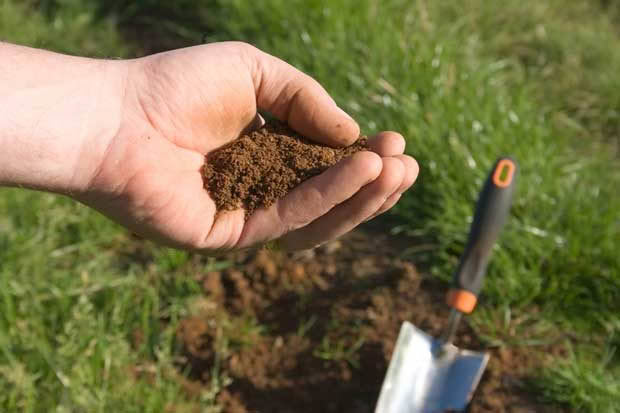
Soil microbes
In a healthy soil there are billions of microbes in addition to the tiny creatures we can see such as earthworms and pill bugs. Like the roots of plants, they need air to breathe. Obviously, waterlogging is not going to be good for them and many will die. Given that soil science has found these microbes to be as critical to the health of plants as our gut flora is to our health, this is not good news for your plants. Microbes play a key role in releasing minerals and nutrients from organic matter (compost and organic mulch) and inorganic matter (crushed rock and soil particles) and making these nutrients available to plants. They are also important in extending the plant root network and increasing the ability of plants to take up water. What the garden really needs next in the flood recovery journey is for the soil microbes to be replenished. This should be the highest priority in any garden that has been waterlogged or flooded – if you do nothing else at all, add microbes! A healthy and diverse soil microbiota will provide bacteria which prey on fungal pathogens. Ongoing wet and hot weather, combined with the loss of natural predators and the increase in dead and rotting plant material, creates the perfect conditions for fungal pathogens to thrive. These are going to be a significant threat to the immediate recovery of many gardens.
Homemade compost is a great source of soil microbes – so long as your compost wasn’t flooded. If your compost was flooded it has lost microbes to waterlogging, as has your soil. If you have access to non-flooded compost, this will be very beneficial. Bagged compost products from the hardware or garden centre are usually sterilised and therefore do not contain living microbes. If the product label does not specifically say it contains live microbes, it does not.
Trees
While soft stemmed plants show immediate signs of stress, most trees do not. By the time a tree starts showing signs of root damage due to flooding or waterlogging, it will be too late to save it. If you have trees, it is highly recommended that you treat them with fungicide within the first couple of weeks post flood, and then microbes in a week’s time. In 2011 we noticed large trees started dying about three months after the flood.
This year (2022) I was able to save almost all of my garden, even salvias, simply by adding microbes and rock minerals containing silica to open the compaction. This worked so well that I decided not to treat my own garden with fungicide, even though I was treating others. I am paying the price now. Six months after the flood, my favourite tree has died. This was not due to a one-off waterlogging incident; it was due to repeated and long-term waterlogging over the six months. I wish I had got in and treated my trees with fungicide when I was treating everyone else’s! By the time my tree showed any signs of not being well, it was too late to save it.
A number of our local fig trees dropped a lot of leaves in the weeks after the flood. This is usually a drought strategy and, in this case, was also a sign of lack of water. It occurs when the roots are damaged and cannot take up the water the tree needs. Some of these trees did not get flooded by riverine flooding, but there has been so much overland flow from rain around them that the ground was completely waterlogged. These trees are now at risk of further damage from fungal pathogens. Because they showed early symptoms, it was obvious they needed help. They have bounced back well. Figs have very vigorous root systems so could grow new roots quickly. Eight months later they do react to weather changes by dropping leaves excessively, indicating that they are still in the root recovery phase. With the return of warm weather there are some fabulous fungi popping up in the mulch under these trees. Not as many as previously, but this too is a sign that the soil life is recovering.
Leaf drop is usually the first sign that a tree is unhappy. Another symptom to look out for is sap oozing from the trunk. This can be a sign of insect attack. Insects are more likely to attack a plant that is weak, so insect attack now can be a sign that the tree is unwell. Oozing sap can also be a symptom of phytophthora infection.
Phytophthora is a group of fungal pathogens which cause severe disease and can be hard to treat. The general fungicides we used in the early stages are unlikely to be effective against phytophthora. Phytophthora tends to kill small plants fairly quickly. Larger shrubs and trees can take months or years to die. It is one of the causes of forest dieback. Once you have it in your soil, it is almost impossible to eradicate. You will need to seek out phytophthora resistant plants for future garden success if it takes hold. It is not the only fungal disease found in gardens. Black spot on roses is also a fungal disease and is easily treatable, as are many common fungal diseases, including most of what you will find after flooding.
Extra care for trees after flooding is a worthwhile investment and is not necessarily difficult or expensive.
Clear mud and debris from against the trunk of the tree. This includes from the forks in branches if you can, as this can create points of disease entry. Trees which have low bushy branches may have a lot of mud amongst the branches that is not easily seen, or easily hosed off, from outside. It can be trapped where the branches join the trunk. Pencil pines and other conifers can be particularly susceptible to this.
They are also very difficult to clean the flood silt off, so you end up with trees that are dull grey below the flood line, even after pressure washing. After both floods here in Brisbane I had conifers to rescue in different gardens. The decision was to remove the lower muddy branches to create a neat trunk. In doing so it was surprising how much mud and debris, including plastic rubbish, was trapped inside the tree’s branches. It also revealed sap oozing from the trunk, a sign that the trees were suffering from fungal infection, most likely phytophthora.
Fungicide sprays applied to the leaves and soil are not helpful once the phytophthora has taken hold. The trees needed phosphorus acid injected into the trunk of the tree. This is not hard to do. Drill a small hole into the cambium layer of the tree. This is the layer of living tissue which contains the vessels which transport water and nutrients around the tree (like our blood vessels). This layer is close to the surface of the tree, depending on its size. You will only need to drill one or two centimetres deep using a fairly small drill bit.
The solution can then be injected into the hole using a small medical syringe. You will not find injection instructions on your bottle as this is not generally performed by home gardeners. The amount you inject will be based on the size of the tree. A very large tree may require multiple (even as many as five) injection sites. The average small tree in a home garden will be fine with one or two at most. A 3-5ml of phosphorus acid is all that should be injected at each site. The phosphorus acid does not eradicate the disease but supports the tree to fight off the infection through its own defense mechanisms.
Fungal infections are not the only problems your tree may face after flooding. Damage to tree roots can cause a tree to become unstable, even if it is not showing signs of poor health. We tend not to think about this until the tree blows over in the next storm. We often don’t think to treat a tree with a seaweed solution, mainly because we can’t reach to foliar spray. Applying a seaweed-based plant tonic to the soil around the tree can help to stimulate new root growth. Make an effort to care for the soil around your tree as you do for the rest of the garden. Healthy soils are vital for healthy plants, trees included.
Pruning branches that cause the tree to be unbalanced can help reduce the stress on the tree and the risk of falling. While the soil remains waterlogged, the risk of further root damage and reduced stability of trees remains. As waterlogging subsides the tree has the chance to grow new roots and to stabilize. If you have any concerns about your trees, please call in a qualified arborist to review them and advise you. Local tree lopping companies may or may not have an arborist working with them. Do check, as you will need this extra level of expertise to be able to advise on the health of your tree. Whilst this does include a cost, removing a dead tree can cost significantly more. Trees are (or should be) integral parts of our gardens. They provide protection for us, our gardens and our homes from weather extremes. For this reason, it is very important to choose the right tree in the first place, and to care for your trees in times of water logging or drought.
Fungal infections are not the only problems your tree may face after flooding. Damage to tree roots can cause a tree to become unstable, even if it is not showing signs of poor health. We tend not to think about this until the tree blows over in the next storm. We often don’t think to treat a tree with a seaweed solution, mainly because we can’t reach to foliar spray. Applying a seaweed-based plant tonic to the soil around the tree can help to stimulate new root growth. Make an effort to care for the soil around your tree as you do for the rest of the garden. Healthy soils are vital for healthy plants, trees included.

Kate Wall is an author and gardening professional based in Brisbane. She has been a subtropical gardener since she was seven years old, but her career changed from environmental science (with scientific qualifications in Biology) to professional gardening after the 2011 floods in which her local community was severely affected. Her volunteer efforts to restore flooded gardens saw her earn several awards including a prestigious Ray Phippard Fellowship from the Lions International. This culture of caring has set the theme for her approach to gardening as she work towards improving people’s lives through making gardening a pleasure and a success. Since 2011 she has been creating and caring for fabulous gardens for clients as diverse as elderly pensioners, kindy and schools, garden enthusiasts, socialites, busy professionals and even a former Governor General.
Kate Wall says: “I hope this book provides the support and know how you need to come out the other side with a better garden than before. If, after reading this, you still have questions, or simply wish to share your experience, you are welcome to email me at thegardenerswall@westnet.com.au. I will do my best to reply.”
